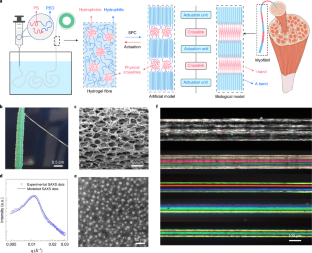2022-06-02 ペンシルベニア州立大学(PennState)
研究チームは、筋繊維の構造を模倣し、効率、作動歪み、機械的特性など、現在の他のアクチュエーターと比較していくつかの面で優れている繊維アクチュエーターを作るための2ステップのプロセスを開発しました。
<関連情報>
- https://www.psu.edu/news/research/story/promising-new-materials-mimic-muscle-structure-and-function/
- https://www.nature.com/articles/s41565-022-01133-0
ナノ構造ブロックコポリマーマッスル Nanostructured block copolymer muscles
Chao Lang,Elisabeth C. Lloyd,Kelly E. Matuszewski,Yifan Xu,Venkat Ganesan,Rui Huang,Manish Kumar & Robert J. Hickey
Nature Nanotechnology Published:02 June 2022
DOI:https://doi.org/10.1038/s41565-022-01133-0

Abstract
High-performance actuating materials are necessary for advances in robotics, prosthetics and smart clothing. Here we report a class of fibre actuators that combine solution-phase block copolymer self-assembly and strain-programmed crystallization. The actuators consist of highly aligned nanoscale structures with alternating crystalline and amorphous domains, resembling the ordered and striated pattern of mammalian skeletal muscle. The reported nanostructured block copolymer muscles excel in several aspects compared with current actuators, including efficiency (75.5%), actuation strain (80%) and mechanical properties (for example, strain-at-break of up to 900% and toughness of up to 121.2 MJ m−3). The fibres exhibit on/off rotary actuation with a peak rotational speed of 450 r.p.m. Furthermore, the reported fibres demonstrate multi-trigger actuation (heat and hydration), offering switchable mechanical properties and various operating modes. The versatility and recyclability of the polymer fibres, combined with the facile fabrication method, opens new avenues for creating multifunctional and recyclable actuators using block copolymers.



